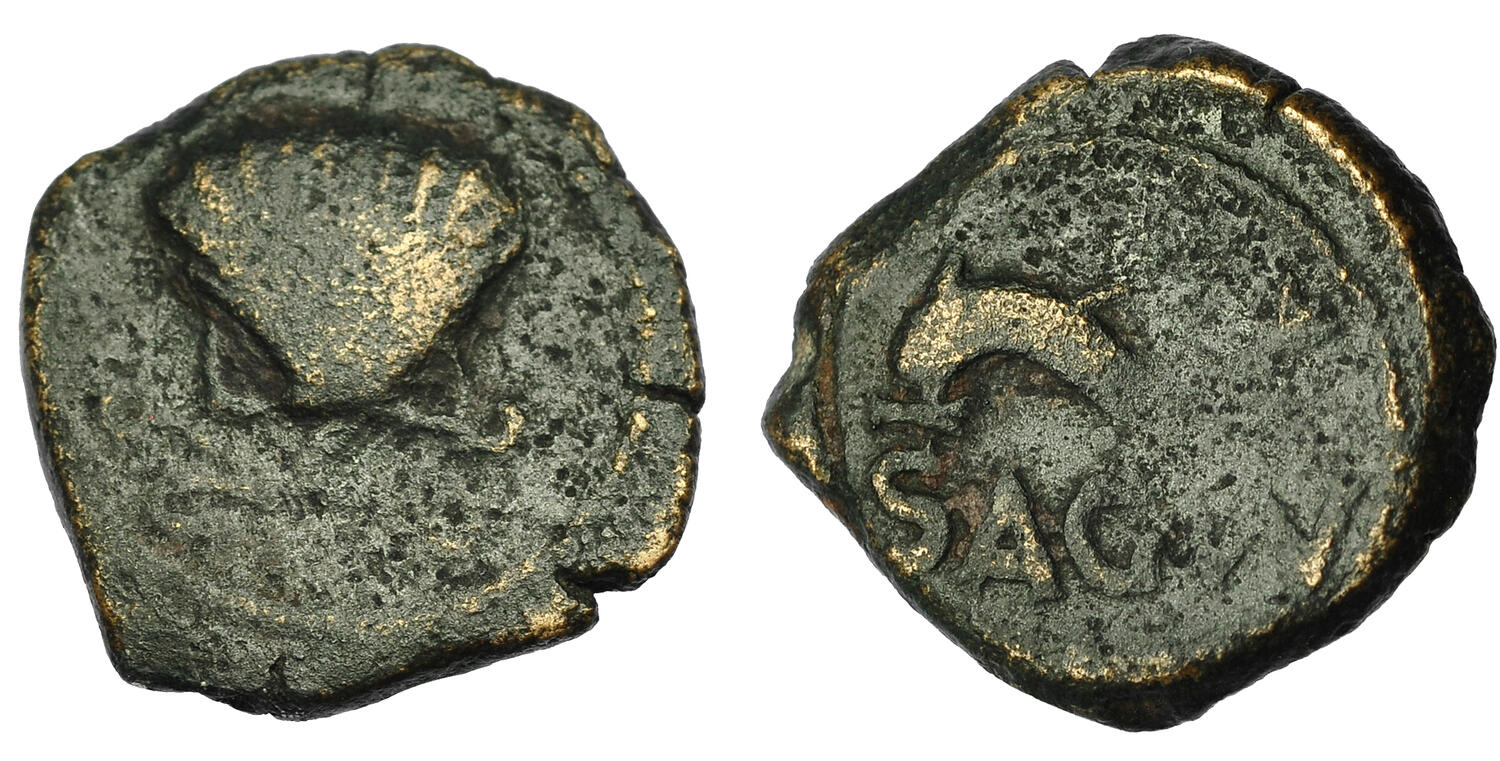Arse-Saguntum (Roman Republic), bronze, quadrantes, ca 4g (pecten/dolphin) (130-72 BCE)
From SILVER
(Redirected from S 1677 - Arse-Saguntum, bronze, quadrantes (130-72 BCE))
130 BCE - 72 BCE Bronze
Description
| ObverseInscription or printing placed on the obverse.: | Shell |
| ReverseInscription or printing placed on the reverse.: | SAGVN (Latin).Dolphin l |
Mint and issuing power
| MintIdentifies the place of manufacture or issue of a numismatic object.: | Arse-Saguntum | Ancient regionAncient region.: | Hispania Citerior | Modern countryModern country: Spain | AuthorityIdentifies the issuing power. The authority can be "pretended" when the name or the portrait of X is on the coin but he/she was not the issuing power. It can also be "uncertain" when there is no mention of X on the coin but he/she was the issuing power according to the historical sources: | Roman Republic |
Chronology
| FromIdentifies the initial date in a range assigned in a numismatic context. | 130 BCE | toIdentifies the final date in a range assigned in a numismatic context.. | 72 BCE | PeriodTime period of the numismatic object.: Hellenistic 323-30 BC |
Physical description
| MetalThe physical material (usually metal) from which an object is made.: | Bronze |
Median weightMedian of the weights of numismatic objects (in grams). in grams | 4.00 | DenominationTerm indicating the value of a numismatic object. Examples: tetradrachm, chalkous, denarius.: | quadrans |
StandardStandard.: |
Image

S 1677 - Arse-Saguntum, bronze, quarters (130-72 BCE).jpg [1]
References
| Die study referencePublication of the study: | Ripollès - Llorens 20021Ripollès - Llorens 2002, p. 450-465, n° 333-382: O176-200/ R238-274 (Period III) | ||
| Coin series referenceReference to coin series study: | ACIP2ACIP, n° 2010 | ||
| Coin series web referenceCoin series web references: | |||
Obverse dies distribution
| FrequencyFrequency of specimen in distribution. ᵖ | Number of obversesNumber of obverse dies. ᵖ (o) | % (o) | Number of coinsNumber of coins. (n) | % (n) | Die nameName(s) of the die(s). |
| 1 | 3 | 12 | 3 | 1.18 | 180, 190, 196 |
| 2 | 1 | 4 | 2 | 0.79 | 177 |
| 3 | 3 | 12 | 9 | 3.54 | 182, 193, 194 |
| 4 | 2 | 8 | 8 | 3.15 | 192, 197 |
| 5 | 2 | 8 | 10 | 3.94 | 189, 199 |
| 6 | 1 | 4 | 6 | 2.36 | 191 |
| 7 | 2 | 8 | 14 | 5.51 | 188, 195 |
| 8 | 1 | 4 | 8 | 3.15 | 179 |
| 9 | 2 | 8 | 18 | 7.09 | 183, 187 |
| 11 | 1 | 4 | 11 | 4.33 | 181 |
| 12 | 1 | 4 | 12 | 4.72 | 176 |
| 14 | 2 | 8 | 28 | 11.02 | 186, 198 |
| 27 | 2 | 8 | 54 | 21.26 | 184, 200 |
| 35 | 1 | 4 | 35 | 13.78 | 178 |
| 36 | 1 | 4 | 36 | 14.17 | 185 |
| Total | 25 of 25 | 100 | 254 of 254 | 99.99 |
Reverse dies distribution
no distribution is available
Quantification
| Number of obversesNumber of obverse dies. ᵖ (o) | 25 | Number of singletons (o1)The number of singleton coins. ᵖ | 3 |
| Number of reverse diesNumber of reverse dies. (r) | 37 | Number of coinsNumber of coins. (n) | 254 |
| Coins per obverse dieNumber of coins per obverse die. (n/o) | 10.16 | Coins per reverse dieNumber of coins per reverse die. (n/r) | 6.86 |
| Reverse per obverse ratioRatio of obverse dies divided by reverse dies. (r/o) | 1.48 | Percentage of singletons (o1)number of coins (n) divided by the number of singletons (o1) ᵖ | 12 % |
| Original number of dies (O) (Carter 1983 formula)The estimation of the number of coins according to Carter 1983 ᵖ | 25.35 | Coins struck if 20,000 as average productivity per dieCoins made if the average productivity for obverses (according to Carter) is 20,000. ᵖ | 507,000 |
| Original number of dies (O) (Esty 2011 formula)The estimation of the number of coins according to the singleton formula in Esty 2011 ᵖ (O) | 27.73 | Survival rate if 20,000 as average productivity per dieSurvival rate if average productivity is 20,000. ᵖ | 0.00050 |
| Coverage (o = % of O) (Esty 1984 formula)Esty 1984 - coverage (% of O) ᵖ (o = % of O) | 98.82% | Die productivity if survival rate 1/2,000Average productivity if survival rate is 1/2,000. ᵖ | 20,039.45 |
| Weight of silver (in kg) if 20,000 coins per die (O = Carter formula)Carter 1983 * Median weight * 20000 (*10 if gold or electrum) ᵖ | n.a. | Die productivity if survival rate 1/5,000Average productivity if survival rate is 1/5,000. ᵖ | 50,098.62 |
Remarks
Most likely one single workstation Likely military See charts p. 201 (with here various die-links), 202 and 203